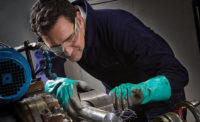
It takes more than compliance mandates to have a successful eye protection program. Employees must also be motivated to wear the proper protection all of the time. Certain motivational "carrots" can be implemented to help achieve compliance.
Despite generally comprehensive safety programs, many thousands of eye injuries still occur in U.S. workplaces each year. Unfortunately the largest number of eye injuries happen because the employee was simply not wearing his or her safety glasses. In some flagrant cases, the employee might assume that an incident is highly unlikely and therefore neglects to wear safety glasses, goggles and face shields because they're considered unattractive and uncomfortable.
Program reassessment
To cut down on eye incidents, reassess your eye safety programs periodically and reinforce mandates in formal employee safety review sessions. Moreover, safety directors need to address objections to wearing eye protection, remove the causes of those objections and incorporate motivational elements and incentives for employees to comply with regulations. A thorough reassessment should include the following:1) Analyze possible causes of eye injuries. Perform a detailed audit of all potential eye hazards in the workplace each time new equipment, processes or procedures are introduced, as well as generally throughout the entire work environment on an annual basis. Keep in mind that most eye injuries are caused by the impact of flying fragments or airborne particles, and many are caused by splashes of hazardous chemical or biological liquids.
2) Review the appropriateness of current eye protection equipment. Let applicable OSHA regulations and the requirements of any applicable standards, such as ANSI Z87.1-1998 and OSHA regulation 29 CFR 1910.133, be your guide. Employees should have the proper eye protection available for the processes conducted in each work area. Some preventive measures that can help reduce the number of flying-fragment and splash injuries include the use of side shields and the use of safety glasses or goggles beneath face shields. Upon completing this review it may be necessary to introduce some new eye safety equipment where needed.
3) Conduct update meetings on eye safety. Annual all-employee meetings to update and reinforce eye and other safety policies are often as important as initial employee training sessions. The safety director can use these meetings to explain OSHA mandates as they apply to that particular workplace. In large companies, this may take the form of "train the trainer sessions" to review material that workplace supervisors should discuss in small group meetings as well as with each new employee. Supervisors and managers can be reminded of what procedures to follow to ensure compliance.
4) Review written policies. Check and update any old regulations that may be included in an employee handbook or posted on bulletin boards or signs throughout the company.
5) Incorporate motivational "carrots." Compliance mandates may be enough to ensure that some employees always take proper precautions. For most workers, though, physical and motivational factors such as comfort, image perceptions and frustration with eyewear may be the most compelling considerations. An eye safety program is likely to gain much greater compliance if motivational "carrots" are utilized. These "carrots" can include:
'Carrots,' not 'sticks'
While enforcement measures and zero-tolerance policies can provide a relatively high baseline for compliance with eye safety mandates, many occasions of non-compliance continue to be cited among the causes for about 1,000 occupation-related eye injuries a day. Employers who review, update and reinforce eye safety mandates in formal employee safety training sessions and include motivational "carrots" in their programs can further reduce the many thousands of eye injuries that continue to occur nationwide each year.Using "carrots" instead of only the "sticks" of zero-tolerance policies can engender employee goodwill and team spirit as well as greater compliance with eye safety regulations.
